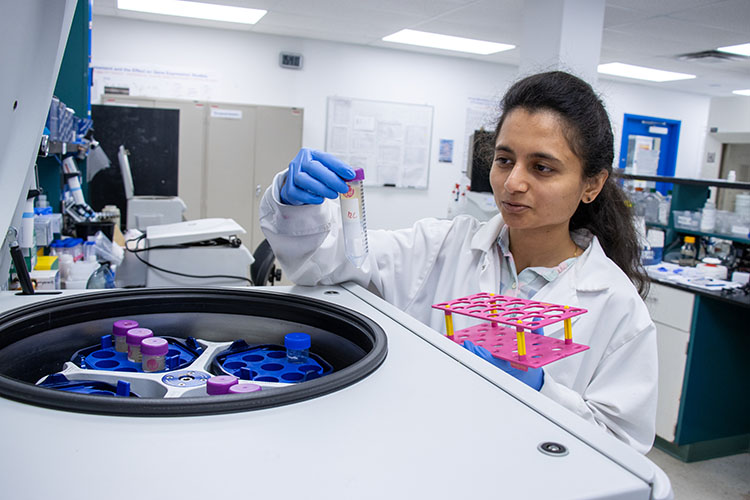Packed full of micro-RNA and other short-fragmented RNA sequences that are crucial for cell-to-cell communication, exosomes have recently become a critical factor in pathology and disease progression. Although seemingly difficult to study due to their low abundance, small size and delicateness, exosomes are present all throughout the human body, purified from various sample types such as plasma, serum, urine, amniotic fluid, cerebrospinal fluid (CSF) and saliva. In this blog, we present to you 3 commonly encountered issues surrounding exosome purification, along with our suggestions and solutions for these uncertainties.
Low Yield
Due to exosomes existing in low abundance within liquid biopsy, the purification of these extracellular vesicles can be quite difficult. Via our proprietary isolation technology, Norgen is able to purify the highest quantities of exosomes from samples for downstream applications, such as Western blot, Nanosight (NTA), Electron Microscopy, and RNA purification, without impacting the integrity or contents of the exosomes.
This is evidenced by a 2020 paper by Reale, et al. where they demonstrated that Norgen’s exosome purification kit obtained superior amounts of extracellular vesicles (EVs) and further confirmed that these EVs were indeed exosomes by correlating this finding with levels of exosome specific protein TSG101. This is further supported by the co-founder and chief scientist at Cancer Treatment Options and Management Inc. (CTOAM), Alex Rolland, who was having issues with isolation quantity before switching to Norgen’s product; “Recently Norgen has worked with us to purify blood-based exosomes and exosomal-RNA at a high enough concentration to allow RNA seq based expression testing… we are able to obtain expression of 20,000 genes from tumour associated exosomes from cancer patients both in remission and experiencing recurrence.” commented Alex Rolland from CTOAM.
Contamination
Exosomes often co-purify with other extracellular vesicles and related structures as they are similar in size. This contaminates the exosome purity and can affect downstream applications as well as confidence in the results. Many popular methods of exosome purification, such as ultracentrifugation, precipitation, and filtration, are size-based and therefore suffer from such contamination. Particularly, the industry-standard ultracentrifugation often results in a single pellet containing everything, including small vesicles, total RNA and small RNA, tediously leading to contaminated outcomes. Similar issues also occur with polyethylene glycol (PEG) precipitation, which is found in many popular commercial kits. Norgen’s Exosome Purification Kits avoid ultracentrifugation and PEG precipitation via our proprietary isolation technology that targets the charge of exosomal surface proteins.
One of the cleanest methods of exosome purification is antibody purification, as it targets exosome-specific surface proteins. A recent comparison of microRNA diversity in size-based separation of exosomes (Ultracentrifugation, ExoQuick, and exoEasy vs surface protein-based isolation of exosomes (Miltenyi Antibodies and Norgen)) demonstrated by heat map shows that Norgen’s proprietary SiC resin matrix yield has the highest resemblance to that of the Miltenyi antibody method. This finding further supports the claim of high purity with Norgen’s method while being significantly cheaper than antibody purification methods.

Loss of Exosome Integrity
Exosomes are quite fragile and therefore are liable to damage or alteration with harsh mechanics or chemistry found in many commercial exosome isolation kits, which can negatively impact downstream applications such as NGS. Norgen avoids this through our proprietary pH-based isolation technology, which alters the isoelectric charges on the membrane-embedded proteins of the exosomes. This method is much gentler with the samples and causes less damage or alteration to the exosomes, thereby leading to greater yield and purity. Norgen Biotek allows for efficient and repeatable exosome purification, which can focus on isolating intact exosomes, exosomal RNA or a combination of both from a variety of samples such as plasma/serum or urine.
Want to hear more from Norgen?
Join over 10,000 scientists, bioinformaticians, and researchers who receive our exclusive deals, industry updates, and more, directly to their inbox.
For a limited time, subscribe and SAVE 10% on your next purchase!
SIGN UP
The field of exosome research is an exciting and developing field filled with numerous applications to human health and disease. While this field holds much promise, there are still many obstacles when it comes to working with exosomes that need to be addressed as the field grows.





